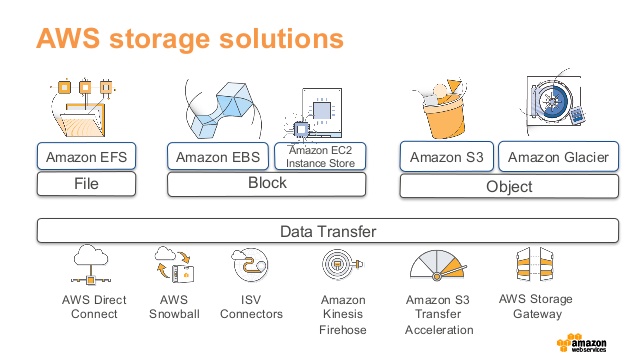Exploring AWS Storage Solutions: Use Cases and Pros/Cons
 Cloud Tuned
Cloud Tuned
Exploring AWS Storage Solutions: Use Cases and Pros/Cons
Amazon Web Services (AWS) offers a comprehensive suite of storage solutions to cater to diverse business needs. From scalable object storage to high-performance block storage, AWS provides a range of services that can be tailored to meet specific requirements. In this article, we will explore some of the key AWS storage solutions, highlighting their use cases, and contrasting their pros and cons.
Amazon S3 (Simple Storage Service)
Overview
Amazon S3 is an object storage service designed to store and retrieve any amount of data from anywhere on the web. It is a highly scalable and durable storage solution with low latency.
Use Cases
Data Backup and Archiving: S3 is an ideal solution for backing up and archiving data. Its durability and availability make it suitable for long-term storage requirements.
Static Website Hosting: S3 can host static websites efficiently. It supports static website hosting with features like versioning and website redirect rules.
Data Lakes: S3 is often used as a primary storage backend for building data lakes. It integrates seamlessly with various analytics and machine learning services.
Pros
Durability and Availability: S3 provides 99.999999999% (11 9's) durability and 99.99% availability over a given year.
Scalability: S3 scales horizontally, allowing users to store virtually unlimited amounts of data.
Lifecycle Policies: S3 enables the automatic transition of objects between storage classes based on specified rules, optimizing costs.
Cons
Pricing Complexity: While S3 offers cost-effective storage, its pricing model can be complex, especially for users with dynamic storage needs.
Data Retrieval Costs: Retrieving large amounts of data from S3 can incur additional costs.
Amazon EBS (Elastic Block Store)
Overview
Amazon Elastic Block Store provides block-level storage volumes that can be attached to EC2 instances. It offers different volume types optimized for various use cases.
Use Cases
Database Storage: EBS volumes are commonly used for storing data used by relational databases, providing low-latency access.
Boot Volumes: EBS volumes can be used as boot volumes for EC2 instances, allowing users to store the operating system and applications.
High-Performance Workloads: EBS provides high-performance SSD-based volumes (e.g., io2) suitable for high-performance workloads like gaming applications.
Pros
Low-Latency Performance: EBS volumes deliver low-latency performance, making them suitable for I/O-intensive applications.
Snapshots: EBS snapshots provide a mechanism for backup and disaster recovery. They can be used to create point-in-time copies of volumes.
Volume Types: EBS offers different volume types, allowing users to choose the right balance of performance and cost for their specific workloads.
Cons
Limited to a Region: EBS volumes are tied to a specific AWS region, which can be a limitation for users requiring cross-region replication.
Scaling Challenges: Scaling EBS can be challenging, and users may need to carefully manage volume size and performance as their workloads evolve.
Amazon Glacier
Overview
Amazon Glacier is a low-cost storage service designed for archiving and long-term backup. It provides three retrieval options, each with different costs and latencies.
Use Cases
Archival Storage: Glacier is ideal for storing data that is infrequently accessed but needs to be retained for compliance or other purposes.
Backup and Restore: Glacier is often used as a cost-effective solution for backup and restore scenarios, especially for large datasets.
Pros
Cost-Effective: Glacier provides a cost-effective solution for storing large amounts of data that doesn't require frequent access.
Durability: Similar to S3, Glacier offers high durability with 99.999999999% (11 9's) durability over a given year.
Cons
Retrieval Times: Retrieving data from Glacier can take several hours, which may not be suitable for time-sensitive workloads.
Data Retrieval Costs: Similar to S3, Glacier has retrieval costs, and retrieving large amounts of data can be expensive.
Amazon EFS (Elastic File System)
Overview
Amazon Elastic File System provides scalable and fully managed file storage that can be easily shared across multiple EC2 instances.
Use Cases
Content Management Systems: EFS is suitable for content management systems that require shared file storage across multiple servers.
Big Data Analytics: EFS is commonly used for big data analytics workloads where multiple instances need access to shared data.
Pros
Scalability: EFS can automatically scale to petabytes without manual intervention.
Shared File System: EFS allows multiple EC2 instances to access the same file system concurrently, making it suitable for collaborative workloads.
Cons
Performance: While EFS provides good performance for many workloads, it may not be suitable for high-performance, low-latency applications.
Cost: EFS can be more expensive than other storage options for certain workloads.
Conclusion
AWS provides a diverse range of storage solutions, each catering to specific use cases and requirements. Understanding the strengths and weaknesses of each service is crucial for making informed decisions based on factors such as performance, durability, scalability, and cost. By carefully evaluating the needs of your applications and workloads, you can leverage the power of AWS storage services to build robust and efficient cloud-based storage solutions.
Subscribe to my newsletter
Read articles from Cloud Tuned directly inside your inbox. Subscribe to the newsletter, and don't miss out.
Written by
